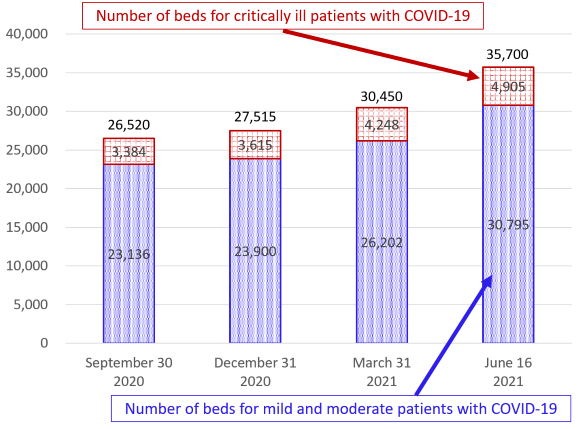Column Finance and the Social Security System 2021.07.14
【Aging, safety net and fiscal crisis in Japan】No.316:Japan is likely to face a fifth COVID-19 wave with a shortage of beds
In this column series, Yukihiro Matsuyama, Research Director at CIGS introduces the latest information about aging, safety net and fiscal crisis in Japan with data of international comparison
Japan has experienced four waves of COVID-19 so far. The peak number of new infections per day was 708 in the first wave (April 10, 2020), 1,597 in the second wave (August 7, 2020), 8,045 in the third wave (January 8, 2021), and 7,239 in the fourth wave (May 8, 2021). The government has issued three states of emergency so far, based on the law enacted in March 2020. The state of emergency is a program that specifies the period and area in which the Prime Minister takes urgent action in the pandemic.
On June 12, the government lifted the third state of emergency, which had been in place since April 25, 2021, for all areas except Okinawa. However, as the number of newly infected patients started to increase, there began to be concerns about a fifth wave. The government unanimously voted to lift the state of emergency because of the Olympics, which is set to begin on July 23. The Suga administration seems to think that if a general election is held immediately after people's feelings are raised by the Olympics, the likelihood of winning the election will increase. Additionally, Prime Minister Suga may believe that the fifth wave can be controlled more easily since more people are getting vaccinated.
According to a document submitted by the Ministry of Finance to the Finance Council in April 2021, the government has contributed JPY 4,597 billion (USD 42 billion) to secure medical institutions that provide medical care for COVID-19 patients. In March 2021, the government urged medical institutions to increase the number of beds available for COVID-19 patients from 30,450 at the end of March to 60,000 in preparation for the fourth wave (see Column No. 302). However, as shown in Figure 1, only 35,700 beds were secured as of June 16. In fact, although there are many vacant beds in both private and public hospitals, the number of beds for COVID-19 patients has not increased despite the large subsidy. As a result, the number of COVID-19 patients that were forced to stay at home reached 34,537 by May 12, and there were several reports of COVID-19 patients suddenly dying at home. In the fifth wave, the highly infectious Delta Variant, which originated in India, is expected to rage. Therefore, we anticipate that the number of infected patients staying at home will again increase. However, the government does not seem to be willing to reform the medical care delivery system to account for this possibility.
Figure 1 The number of beds for COVID-19 patients

Source: Ministry of Health, Labor and Welfare
Figure 2 The number of COVID-19 patients at home or in hotels

Source: Ministry of Health, Labor and Welfare
